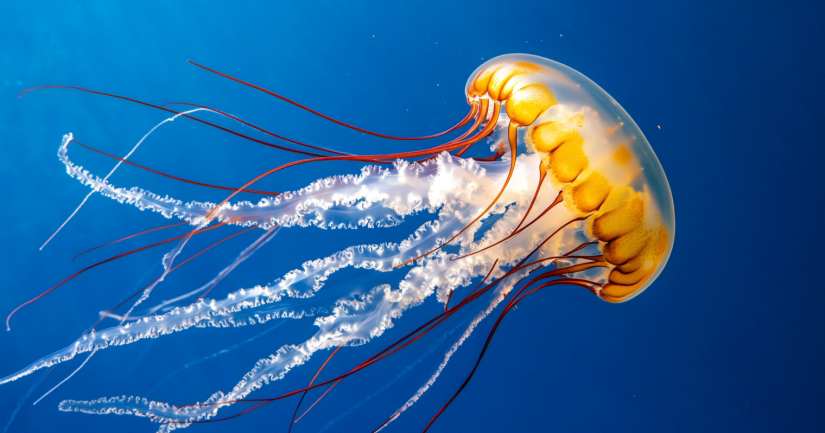
Jellyfish Quiz Test Your Knowledge of These Mysterious Ocean Drifters! Drifting through the oceans like ghostly, otherworldly creatures, jellyfish have been gliding through Earth’s waters for over 500 million year making them one of the oldest living species on the planet! Despite their delicate, translucent appearance, these mesmerizing marine animals are both fascinating and dangerous, with some species delivering potent stings that can paralyze prey or even harm humans. But how much do you really know about jellyfish? Take our Jellyfish Quiz and dive into the incredible world of these ancient ocean wanderers!
Jellyfish belong to the phylum Cnidaria, which also includes corals and sea anemones. Unlike most animals, they have no brain, no bones, and no heart, yet they thrive in every ocean on Earth, from shallow coastal waters to the deep, dark abyss. Instead of a central nervous system, jellyfish rely on a nerve net that helps them detect changes in their environment.
Mesmerized by jellyfish? Float over to our Humpback Whale Trivia for more marine marvels, or discover the unique world of crustaceans in our Crab Trivia.
Mind-Blowing Jellyfish Facts That Might Surprise You
Jellyfish Are One of the Oldest Animal Species – They predate dinosaurs, trees, and even sharks, existing for more than 500 million years!
They Can Be Bioluminescent – Some deep-sea jellyfish species, like the Atolla jellyfish, produce glowing lights to confuse predators and attract prey.
They Don’t Have Brains, Yet They Can Hunt – Even without a brain, jellyfish can sense movement and detect prey using specialized nerve cells and tentacles.
The Portuguese Man o’ War Isn’t a Jellyfish – Often mistaken for a jellyfish, this dangerous drifter is actually a colony of specialized organisms working together as one.
The Immortal Jellyfish (Turritopsis dohrnii) Can Live Forever – This species has the ability to revert back to its juvenile stage, meaning it can potentially avoid death and restart its life cycle indefinitely.
Jellyfish Blooms Can Take Over Entire Ecosystems – In some parts of the world, jellyfish populations have exploded, disrupting fishing industries and even clogging power plants.
Some Jellyfish Stings Can Be Deadly – The box jellyfish is one of the most venomous creatures on Earth, with a sting that can cause cardiac arrest in minutes.
The Role of Jellyfish in Marine Ecosystems
Jellyfish are often seen as ocean nuisances, but they play an important role in marine ecosystems. They provide food for many predators, including sea turtles, sunfish, and certain deep-sea fish. Additionally, some jellyfish help transport nutrients through the ocean, supporting the delicate balance of marine food chains.
However, climate change, overfishing, and pollution have led to jellyfish population explosions in some regions, disrupting fisheries and coastal tourism. Scientists are studying these creatures to understand their role in ocean health and how humans can better manage their presence.
Are You Ready to Take the Ultimate Jellyfish Quiz?
If you’re fascinated by marine biology, ocean conservation, or the mysteries of deep-sea creatures, this Jellyfish Quiz is for you! Whether you’re a casual ocean lover or an expert on aquatic life, this quiz will challenge your knowledge and reveal incredible facts about these hypnotic yet powerful sea creatures.
So, are you ready to test your knowledge and explore the world of jellyfish? Take the Jellyfish Quiz now and see if you’re a true ocean expert! 🌊🪼
Love the ocean? Test your knowledge with the Guess the Sea Animal Quiz, discover your marine match in the What Sea Animal Am I Quiz, or explore more Marine Quizzes for underwater fun!
Jellyfish – FAQ
Jellyfish are gelatinous, free-swimming creatures belonging to the phylum Cnidaria. They are primarily composed of water and lack a centralized brain or complex organs. Jellyfish play a crucial role in marine ecosystems as both predators and prey. They help control populations of small fish and plankton, while also serving as food for larger marine animals like sea turtles.
Jellyfish have a unique reproductive cycle that includes both asexual and sexual reproduction. They typically reproduce sexually by releasing eggs and sperm into the water, where fertilization occurs. The fertilized eggs develop into larvae called planulae, which eventually settle and grow into polyps. These polyps can reproduce asexually, producing more jellyfish through budding.
While many jellyfish possess stinging cells called nematocysts, not all species are harmful to humans. Some, like the moon jellyfish, have mild stings that may cause slight irritation. However, species such as the box jellyfish can deliver severe stings that may be life-threatening. It is essential to be cautious and aware of local jellyfish species when swimming in their habitats.
The lifespan of a jellyfish varies significantly among species. Some may live for just a few months, while others can endure for several years. The immortal jellyfish, known scientifically as Turritopsis dohrnii, possesses a unique ability to revert to its juvenile form after maturing, potentially allowing it to live indefinitely under optimal conditions.
Jellyfish populations can be influenced by various environmental factors, including ocean temperature, salinity, and overfishing of their natural predators. Warmer waters often lead to increased jellyfish blooms, which can disrupt local ecosystems and fisheries. Monitoring these changes is vital for understanding and managing marine biodiversity.
